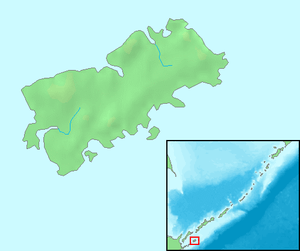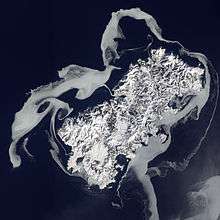Shikotan
| Disputed island Other names: Russian: Шикотан; Japanese: 色丹島 | |
|---|---|
|
NASA picture of Shikotan Island | |
| Geography | |
 | |
| Location | Pacific Ocean |
| Coordinates | 43°48′N 146°45′E / 43.800°N 146.750°E |
| Archipelago | Kuril Islands |
| Total islands | 1 |
| Area | 225 square kilometres (56,000 acres) |
| Highest point |
|
| Administered by | |
| Russia | |
| District | Sakhalin |
| Claimed by | |
| Japan | |
| Prefecture | Hokkaido |
| Capital city | Tokyo |
| Russia | |
| District | Sakhalin |
| Demographics | |
| Population | 2,100 |
Shikotan (Russian: Шикотан; Japanese: 色丹島 (Shikotan); Ainu: シコタン or シコタヌ, Sikotan), also known as Shpanberg (after Martin Spangberg), is an island which is administered by the Russian Federation as part of Yuzhno-Kurilsky District of Sakhalin Oblast, and that is claimed by Japan as part of Nemuro Subprefecture of Hokkaido Prefecture. Russia recognised Japanese sovereignty over the island in the 19th century. In September 1945, during the final days of World War II, the island was invaded by 600 Soviet troops.[1] It is one of the islands (along with the Habomai Islands) which the Soviet Union agreed in 1956 to transfer to Japan in the event of a peace treaty between the two countries (such a peace treaty has never been concluded).[2] The name of Shikotan derives from the Ainu language and means "the village proper" or "real town".
The total land area of Shikotan is 225 km². The island is hilly, averaging 300 metres in elevation. The shores of the island are very indented and covered with oceanic meadows. The highest altitude is 412 m. The island is formed by the volcanic rock and sandstone of the Upper Cretaceous and Cenozoic periods. There are two extinct volcanoes on Shikotan: Mount Tomari and Mount Notoro.
Shikotan's vegetation consists mostly of Sakhalin fir, larch, deciduous trees, bamboo underbrush, and juniper brushwood.
There are two settlements: Malokurilskoye (formerly Shikotan or Shakotan) and Krabozavodskoye (formerly Anama).
The primary economic activities are fisheries and fishing, with the principal marine products being cod, crab, and kelp.
An earthquake and subsequent tsunami caused major damage on the island's coastline on October 4, 1994.
In popular culture
The 2014 anime film Giovanni's Island is a fictionalized account of the fate of Japanese civilians living on Shikotan at the time of the 1945 Soviet occupation.
Gallery
 Relief Map
Relief Map Shikotan Island, 1990.
Shikotan Island, 1990. Shikotan, 1980.
Shikotan, 1980. Lighthouse, 1980.
Lighthouse, 1980. Landscape, 1980.
Landscape, 1980.

See also
References
- ↑ "Japan's prime minister plans a steamy tête-à-tête with Russia's president". The Economist. 10 September 2016. Retrieved 8 April 2018.
- ↑ "Texts of Soviet–Japanese Statements; Peace Declaration Trade Protocol". The New York Times, page 2, October 20, 1956.
Moscow, October 19. (UP) – Following are the texts of a Soviet–Japanese peace declaration and of a trade protocol between the two countries, signed here today, in unofficial translation from the Russian
...The U.S.S.R. and Japan have agreed to continue, after the establishment of normal diplomatic relations between them, negotiations for the conclusion of a peace treaty. Hereby, the U.S.S.R., in response to the desires of Japan and taking into consideration the interest of the Japanese state, agrees to hand over to Japan the Habomai and the Shikotan Islands, provided that the actual changing over to Japan of these islands will be carried out after the conclusion of a peace treaty...
External links
| Wikimedia Commons has media related to Shikotan. |